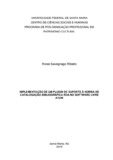| dc.creator | Ribeiro, Ronai Savegnago | |
| dc.date.accessioned | 2021-05-05T00:39:05Z | |
| dc.date.available | 2021-05-05T00:39:05Z | |
| dc.date.issued | 2019-08-15 | |
| dc.identifier.uri | http://repositorio.ufsm.br/handle/1/20774 | |
| dc.description.abstract | Giving access to cultural heritage, whether documentary or not, is one of the guarantees that the records that the human being created and documented will not be forgotten. And one of the ways to allow access is to carry out an archival description, in a systematic way and attending norms and standards suitable for that. In this context, we present the AtoM archival description software, an acronym for Access to Memory, which starts from an open source project and allows the archival community to perform tasks of such descriptions. However, the description of documents or objects is not exclusive to the archival community, but also the area of librarianship, which performs bibliographical description, following its respective norms. Thus, this research aims to implement a plugin for open source AtoM software that supports the RDA bibliographic description standard. The justification for this research is contained in the fact that the AtoM description platform can be used by the librarianship community, just as the RDA standard, which was designed to describe objects from areas other than bibliographic, may be available in the software. As a theoretical reference for this research, references were used to conceptualize the cultural heritage, emphasizing the identification of archival and bibliographic documentary heritage in this context. Also discussed and contextualized the topics of archival description, an analysis referring to the AtoM software and its design structure, and a contextualization of the standard of bibliographic description RDA. This research is applied, descriptive and characterized as a bibliographical research. With this, it was possible to identify the archival and bibliographic document as documentary and cultural heritage, identify the way that AtoM software is implemented and perform an analysis in the theoretical framework of the RDA bibliographic standard. And finally, as a result and product, is a new version of AtoM, supporting the bibliographic description of the RDA standard. | eng |
| dc.language | por | por |
| dc.publisher | Universidade Federal de Santa Maria | por |
| dc.rights | Attribution-NonCommercial-NoDerivatives 4.0 International | * |
| dc.rights.uri | http://creativecommons.org/licenses/by-nc-nd/4.0/ | * |
| dc.subject | AtoM | por |
| dc.subject | RDA | por |
| dc.subject | Descrição | por |
| dc.subject | Arquivística | por |
| dc.subject | Bibliografia | por |
| dc.subject | Description | eng |
| dc.subject | Archival | eng |
| dc.subject | Bibliography | eng |
| dc.title | Implementação de um plugin de suporte à norma de catalogação bibliográfica RDA no software livre AtoM | por |
| dc.title.alternative | Implementation of a plugin supporting the bibliographic cataloging standard RDA in open-source software AtoM | eng |
| dc.type | Dissertação | por |
| dc.description.resumo | Dar acesso ao patrimônio cultural, seja documental ou não, é uma das garantias de que os registros que o ser-humano criou e documentou não serão esquecidos. E uma das formas de permitir acesso é realizar uma descrição arquivística, de uma forma sistemática e atendendo normas e padrões adequados para tal. Neste contexto, apresenta-se o software de descrição arquivística AtoM, acrônimo de Access to Memory, que parte de um projeto de código aberto e permite à comunidade arquivística realizar tarefas de tais descrições. Porém, a descrição de documentos ou objetos não é exclusiva à comunidade arquivística, mas também a área da biblioteconomia, que realiza descrição bibliográfica, seguindo suas respectivas normas. Assim, esta pesquisa tem como objetivo a implementação de um plugin para o software de código aberto AtoM que suporte a norma de descrição bibliográfica RDA. A justificativa para esta pesquisa está contida no fato de que a plataforma de descrição AtoM pode ser aproveitada pela comunidade da biblioteconomia, assim como a norma RDA, que foi concebida visando também descrever objetos de outras áreas além da bibliográfica, possa estar disponível no software. Como referencial teórico para esta pesquisa, foram utilizados referenciais que conceituassem o patrimônio cultural, salientando a identificação do patrimônio documental arquivístico e bibliográfico neste contexto. Também foram discutidos e contextualizadas as temáticas de descrição arquivística, uma análise referente ao software AtoM e sua estrutura de projeto, e uma contextualização da norma de descrição bibliográfica RDA. Esta pesquisa é de natureza aplicada, descritiva e caracterizou-se como uma pesquisa bibliográfica. Com isto, foi possível identificar o documento arquivístico e bibliográfico como patrimônio documental e cultural, identificar a forma que o software AtoM está implementado e realizar uma análise no referencial teórico da norma bibliográfica RDA. E por fim, como resultado e produto, está uma nova versão do AtoM, suportando a descrição bibliográfica da norma RDA. | por |
| dc.contributor.advisor1 | Flores, Daniel | |
| dc.contributor.advisor1Lattes | http://lattes.cnpq.br/9640543272532398 | por |
| dc.contributor.referee1 | Viana, Gilberto Fladimar Rodrigues | |
| dc.contributor.referee2 | Schmitt, Marcelo Augusto Rauh | |
| dc.creator.Lattes | http://lattes.cnpq.br/4417198720590759 | por |
| dc.publisher.country | Brasil | por |
| dc.publisher.department | História | por |
| dc.publisher.initials | UFSM | por |
| dc.publisher.program | Programa de Pós-Graduação em Patrimônio Cultural | por |
| dc.subject.cnpq | CNPQ::CIENCIAS HUMANAS::HISTORIA | por |
| dc.publisher.unidade | Centro de Ciências Sociais e Humanas | por |



